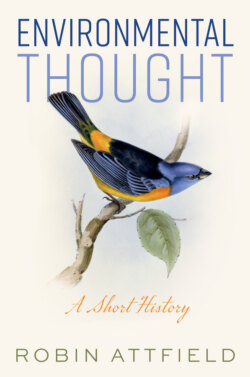Читать книгу Environmental Thought - Robin Attfield - Страница 21
Saints and beasts, monks and farming
ОглавлениеThe successors of St Antony spread his ideas and practices, and tales of gentleness towards animals became associated with Celtic saints such as Brendon (sixth century) and Northumbrian saints such as Cuthbert (seventh century) (Waddell 1995). The detailed veracity of these stories matters less than the widespread veneration of these saints among Christians throughout the Middle Ages (and beyond). This veneration fostered a gentle attitude to animals, both wild (such as seals and ravens) and domestic (such as sheep and dogs), albeit one contrasting with traditions of hunting (in which, for example, Basil the Great joined) (Coates 1998: 56), and also with anthropocentric teachings spread by followers of church fathers such as Augustine. While this was an age when many wild animals were hunted to extinction, the lives of the saints also exercised an important influence on attitudes to nature, particularly among the poor and the unlearned. Meanwhile, some small contributions were made by Byzantine scholars to both zoology and botany (Egerton 2012: 17).
We now turn to monasticism, and the emergence of monasteries and nunneries. Following the Rule of Benedict (c. 480–c. 544), itself based on the teachings of Basil the Great in the East, the Benedictines founded the first of many monasteries at Monte Cassino in Italy in the early sixth century. The monks’ main activities, besides prayer and worship, consisted in gardening and farming. ‘St Benedict’, writes René Dubos, ‘believed that it was the duty of the monks to work as partners of God in improving his creation … implicit in his writings is the thought that labour is like a prayer which helps in recreating paradise out of chaotic wilderness’ (1974: 126, 131–2; see also Coates 1998: 56–7). Dubos finds here a continuation of the ancient tradition (as depicted by Passmore) of completing and perfecting an unfinished creation, adding that such a creative stewardship of the earth is compatible with reverence for nature. While not all monasteries always lived up to these ideals, Western monasteries contributed to establishing a pattern of fertile farmland, and also of islands of order, in turbulent and unpredictable times.
Before we turn to White’s discussion of medieval technology, it is appropriate to pause to remark other changes to the landscape taking place in this period, with special reference to England and Wales. Pre-Roman deforestation seems to have emptied these lands of bears, and largely of beavers, and by 1400 wolves were extinct here too, but not yet in Scotland. The Saxon invaders found a land rich in fields, villages and farmsteads, adding places with names ending in ‘ley’ (a forest clearing), such as King’s Langley and Abbot’s Langley in Hertfordshire, and ‘hurst’ (a settlement in a clearing) such as Chislehurst in Kent, albeit not in great abundance (Coates 1998: 43–4). Much later, in the early twelfth century, Cistercian monks arrived and by 1300 had established 230 abbeys and priories, from the Moray Firth in Scotland to Tintern in Wales (and across Europe as far as Hungary). They adhered to the Rule of Benedict, and cleared land for cultivation at the same time, but sometimes displaced local people as they did so (Coates 1998: 44). Much forest clearance was also conducted at their behest (Glacken 1967: 214).
